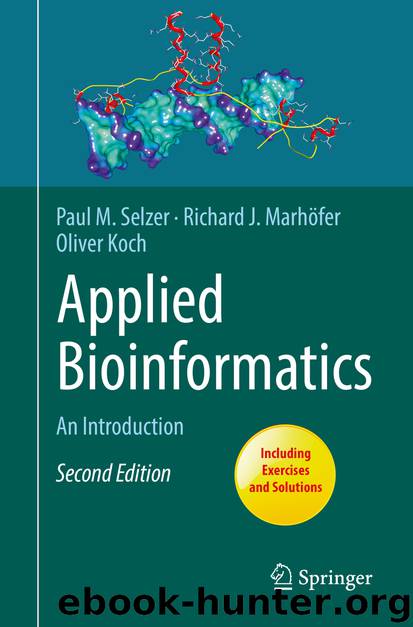Applied Bioinformatics by Paul M. Selzer & Richard J. Marhöfer & Oliver Koch

Author:Paul M. Selzer & Richard J. Marhöfer & Oliver Koch
Language: eng
Format: epub
ISBN: 9783319683010
Publisher: Springer International Publishing
Each expression profiling experiment generates an enormous amount of data. One experiment can include dozens of microarrays, which in turn consist of several thousand spots. Therefore, the resulting several hundred thousand or even millions of measurements must be managed and analyzed using special databases in which the data can be saved and retrieved at any time. Example databases are the Gene Expression Omnibus of the National Center for Biotechnology Information (NCBI) [geo] and the ArrayExpress of the European Bioinformatics Institute (EBI) [arrayexpress]. In addition to results, one can also find unprocessed raw data as well as the protocols and conditions under which the experiments were performed. These data should comply with the minimum information about a microarray experiment [miame] protocol in which the minimum requirements for an explicit interpretation and reliable reproduction of the microarray experiments are defined (Brazma et al. 2001).
In summary, performing microarray experiments, inclusive of the bioinformatic component, is complex and places high demands on the experimenter. Luckily, a variety of software solutions exist that simplify the analysis of the data. A known commercial program for the analysis of microarray data is the GeneSpring GX collection of Agilent Technologies [agilent]. Frequently used software packages that were developed in the academic environment are Bioconductor [bioconductor], the TM4 suite [tm4], and GenePattern [genepattern].
Besides expression profiling there are a variety of other applications for microarrays (Gershon 2005) that have gained increasing importance, for example in tumor medicine. The optimal treatment of a cancer patient is critically dependent on a diagnosis that is as precise as possible, which at present is based on a combination of clinical and histopathological data. In some cases, however, an exact diagnosis is difficult because tumors frequently have atypical properties. In such cases microarrays can help classify tumors according to their gene expression profiles. An example is acute leukemia. This cancer of leukocytes can be subdivided into acute lymphoblastic leukemia (ALL) and acute myeloid leukemia (AML) using clinical and morphological data for diagnostics. The distinction of these subtypes is essential because each is treated with different chemotherapeutics. An initial study (Golub et al. 1999) examined whether reliable results could be obtained by molecular diagnostics with the help of DNA microarrays compared to classical methods. The gene expression profiles from patients with a known diagnosis were analyzed and then compared with those from patients with an unknown diagnosis. The result demonstrated that the microarray diagnostic tool was reliable. In addition, a patient with a diagnosed atypical acute leukemia was also examined. Here the microarray diagnostic tool showed that this patient’s gene expression profile was completely different from those of other patients. Its profile pointed more to a cancer of muscle tissue than to an acute leukemia. Because cytogenetic examinations also disagreed with an acute leukemia diagnosis and favored a muscle tumor, the final diagnosis and chemotherapy were changed accordingly. Thus, the classification of tumors based on DNA microarrays provides validated support to the standard diagnostic techniques (Golub et al. 1999).
Another important field for the application of microarray technology is toxicology.
Download
This site does not store any files on its server. We only index and link to content provided by other sites. Please contact the content providers to delete copyright contents if any and email us, we'll remove relevant links or contents immediately.
| Anatomy | Animals |
| Bacteriology | Biochemistry |
| Bioelectricity | Bioinformatics |
| Biology | Biophysics |
| Biotechnology | Botany |
| Ecology | Genetics |
| Paleontology | Plants |
| Taxonomic Classification | Zoology |
Sapiens: A Brief History of Humankind by Yuval Noah Harari(14319)
The Tidewater Tales by John Barth(12625)
Mastermind: How to Think Like Sherlock Holmes by Maria Konnikova(7278)
Do No Harm Stories of Life, Death and Brain Surgery by Henry Marsh(6905)
The Thirst by Nesbo Jo(6877)
Why We Sleep: Unlocking the Power of Sleep and Dreams by Matthew Walker(6654)
Life 3.0: Being Human in the Age of Artificial Intelligence by Tegmark Max(5512)
Sapiens by Yuval Noah Harari(5322)
The Longevity Diet by Valter Longo(5040)
The Body: A Guide for Occupants by Bill Bryson(5027)
The Rules Do Not Apply by Ariel Levy(4910)
The Immortal Life of Henrietta Lacks by Rebecca Skloot(4548)
Animal Frequency by Melissa Alvarez(4424)
Why We Sleep by Matthew Walker(4394)
The Hacking of the American Mind by Robert H. Lustig(4338)
Yoga Anatomy by Kaminoff Leslie(4332)
All Creatures Great and Small by James Herriot(4269)
Double Down (Diary of a Wimpy Kid Book 11) by Jeff Kinney(4240)
Embedded Programming with Modern C++ Cookbook by Igor Viarheichyk(4141)
